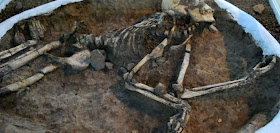 |
| Over 100 'vampire' graves have been found in Bulgaria in recent years [Credit: Hristina Dimitrova] |
This appears to be the first find of this kind (or the first publicised one, at least) at Perperikon – a treasure trove that archaeologists are still not finished exploring after more than a decade of digging, given that the site has been inhabited since the early Iron Age well into the medieval era.
Coins found with the body have been tentatively dated to the 13th and 14th century. The skeleton appears to belong to a male aged 35 to 40, Ovcharov said.
“I say that he is almost a ‘twin’ of the Sozopol [vampire] because on the left side, between his neck and chest, there is a massive ploughshare. In other cases we have found nails and spikes, but there is no other known case, except the one in Sozopol, where a ploughshare was used. It is a ritual to prevent undeath,” Ovcharov said on September 2, as quoted by Focus news agency.
The remains of the Sozopol ‘vampire’ returned to the town earlier this summer, alongside a bust made using forensic facial reconstruction. According to the director of the National History Museum in Sofia and Sozopol native Bozhidar Dimitrov, the “vampire” might have been a historical figure – the pirate Krivich, who lived in the 13th century and appears to have acted as a town mayor at some point in his life.
Ovcharov, one of Bulgaria’s best-known archaeologists, has been leading archaeological digs at Perperikon for 13 years now and said earlier this spring that he hoped to finish work on the Perperikon acropolis this season.
This season’s digs focused on a part of the acropolis that held a large altar dating back to the first millennium BCE, a late antiquity Roman temple, as well as the medieval bishop’s palace from the 13th-14th century.
Perperikon, in Bulgaria’s eastern Rhodopes region, about 15km from the town of Kurdjali, has been the site of various forms of religious activity from about 7000 years ago, having first been used by the Thracians. The site is a popular tourist attraction and long-term archaeological work continues to unveil new discoveries.

No comments:
Post a Comment